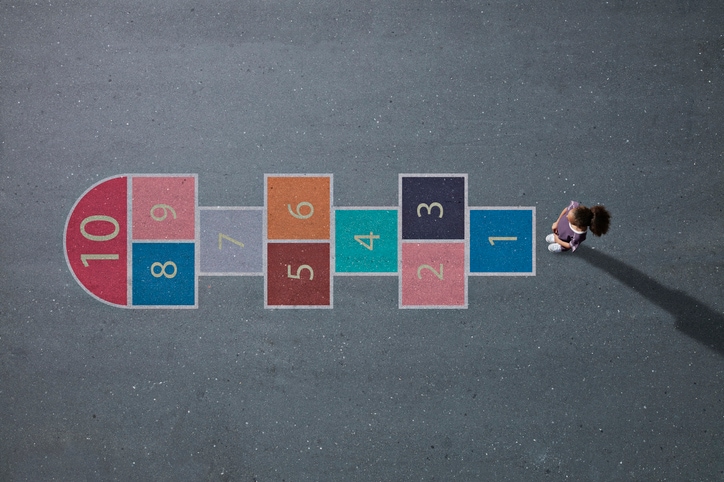Hopscotch rules are simple, but variations can add fun twists and new challenges to the game. It’s easy to learn, gets kids outside, involves some level of physical challenge and can be played by everyone.
“I often hear it described as a girls’ game, but in my Boston neighborhood, growing up in the ’70s, boys and girls both played because it combines coordination with a random factor,” says Joshua Glenn, the co-author of the “UNBORED” activity books and activities. “No matter how athletic you are, you don’t know exactly where the tossed object will land, and no matter how lucky you are, you have to be coordinated.”
Kids crave movement and activity, and they need it for their physical development. A game like hopscotch makes children jump and bend in quick bursts of energy, which is how children naturally play.
“To create ideal movement patterns, children need a basal level of strength,” says Dr. Greg Myer, the director of the Human Performance Lab and director of research at the division of sports medicine at Cincinnati Children’s Hospital Medical Center. Teaching games like hopscotch gives your kids a go-to strength-building activity they can play alone or in groups anytime and anywhere. “It has to be fun. If it’s not fun they’re not going to do it,” Myer adds.
How to draw a hopscotch board
There are many variations, but a standard board starts with the number 1 in front, 2 and 3 next to each other, 4 alone, 5 and 6 on the same line, 7 alone, 8 and 9 next to each other and finally 10 at the end.
What you need to play hopscotch
All you need to play hopscotch outdoors is a stick to draw in the dirt or chalk to write on the pavement, and a stone to use as your marker. Indoors, use painter’s tape to create a board and a checkers game piece for the marker.
Hopscotch rules for how to play
The goal is to make it up and back from square 1 to square 10 while playing by the following hopscotch rules:
- You get two tries to toss the marker into square one.
- If the marker lands on the first square, your turn begins. Hop over the square with the marker.
- You can only place one foot on a square at a time.
- If two squares are next to each other, land with both feet on the ground, one foot per square. In a row with only one square, you may only land with one foot.
- Hop and jump your way up the course from 1 to 10, skipping the square with the marker. Use 10 as a rest stop, then turn around and go back toward 1, landing one foot per square at a time in the same way.
- When you get to the marker, pick it up, balancing carefully.
- If you make it all the way up and back without stepping outside of the squares or missing a square, move on by throwing the marker into the next number.
- As soon as you step outside of a square, miss your toss or place two feet in one square, your turn is over.
Variations on hopscotch
Beginner rules allow you to start from the last number you completed. In advanced play, you must start from square number 1 at every turn. There are many other variations of the game that make it fun, interesting and keep it challenging.
- Escargot: Change the course by varying the size and arrangements of the board, or do as the French do: They arrange the numbers in a spiral like a snail and call it “escargot.”
- Kick the stone: In another challenging variation, you can kick the stone as you hop from one square to the next.
- Potsy: In Glenn’s new book “UNBORED Adventure,” they give rules for a hopscotch game called Potsy. “You draw a line of 10 attached squares, and in each one you write the name of a category (‘TV show,’ say, or ‘Ice Cream Flavor’). You play it more or less like hopscotch, but as you run the course, you have to bounce a ball into each square while shouting examples of each category (‘Adventure Time!,’ ‘Chocolate!’),” says Glenn. “What we like about Potsy is how it combines coordination with quick thinking and a command of knowledge about all sorts of categories.”
No matter how you play the game of hopscotch with kids, everyone’s sure to enjoy an afternoon of fun.




